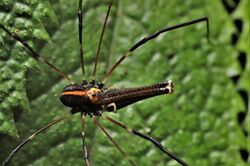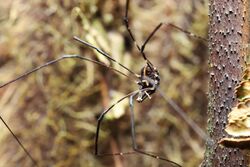Biology:Forsteropsalis pureora
| Forsteropsalis pureora | |
|---|---|

| |
| Male Forsteropsalis pureora | |

| |
| Female Forsteropsalis pureora | |
| Scientific classification | |
| Domain: | Eukaryota |
| Kingdom: | Animalia |
| Phylum: | Arthropoda |
| Subphylum: | Chelicerata |
| Class: | Arachnida |
| Order: | Opiliones |
| Family: | Neopilionidae |
| Genus: | Forsteropsalis |
| Species: | F. pureora
|
| Binomial name | |
| Forsteropsalis pureora Taylor, 2013
| |
Forsteropsalis pureora is a species of long-legged harvestman in the family Neopilionidae.[1] This species is endemic to New Zealand, found in the North Island.[1] They are found in native forest, often resting on vegetation or stream banks.[2]
Description
This species is highly sexually dimorphic, with males and females differing in morphology.[3] Males have enlarged chelicerae used to fight other males in competition.[3] The pinching claw of the chelicera is used to grab and pin down the opponent.[3] Males may be one of three morphs that differ in chelicerae size, chelicerae shape, and body size.[3] Males and females also differ in color, known as sexual dichromatism.[4] Males are brown to black with an orange stripe running dorsally down the body.[1][4] There is also an orange horseshoe-shaped marking around the eyes.[1][4] In the original species description, these markings are inaccurately described as white from the aged bleached specimens in ethanol.[1][4] The orange markings may range from dull yellow-orange to dark red-orange. Females are more cryptic in color with a mottled brown and black pattern and light yellow-orange markings. Juveniles have the same coloration as mature females.[4]
Diet and predators
This species is a generalist opportunistic omnivore. In the wild, they have been observed eating a variety of insect prey (e.g., wētā, flies, beetles, dragonflies, caterpillars, adult moths, stink bugs, and cockroaches), spiders, and other invertebrates (e.g., amphipods), both captured live and scavenged.[2] They are highly opportunistic and have been found resting under spider webs collecting discarded pieces of prey as they fall from the web.[2]
New Zealand harvestmen are eaten by various vertebrate species, including introduced mammals (possums, hedgehogs, rats, stoats), bats, birds, frogs, tuatara, and fish (kōaro).[2] Invertebrate predators such as spiders also prey upon harvestmen and cannibalism occurs within the Neopilionidae.[2] Forsteropsalis pureora has been observed being eaten by Uliodon sp. vagrant spiders and Cambridgea sp. sheetweb spiders.[2]
References
- ↑ 1.0 1.1 1.2 1.3 1.4 Taylor, Christopher (2013-02-28). "Corrigenda: Taylor CK (2013) Further notes on New Zealand Enantiobuninae (Opiliones, Neopilionidae), with the description of a new genus and two new species. ZooKeys 263: 59–73". ZooKeys (273): 107. doi:10.3897/zookeys.273.4857. ISSN 1313-2970.
- ↑ 2.0 2.1 2.2 2.3 2.4 2.5 Powell, Erin C.; Painting, Christina J.; Hickey, Anthony J.; Machado, Glauco; Holwell, Gregory I. (2021-05-11). "Diet, predators, and defensive behaviors of New Zealand harvestmen (Opiliones: Neopilionidae)". The Journal of Arachnology 49 (1). doi:10.1636/joa-s-20-002. ISSN 0161-8202.
- ↑ 3.0 3.1 3.2 3.3 Powell, Erin C; Painting, Christina J; Hickey, Anthony J; Holwell, Gregory I (2020-04-25). "Defining an intrasexual male weapon polymorphism in a New Zealand harvestman (Opiliones: Neopilionidae) using traditional and geometric morphometrics". Biological Journal of the Linnean Society 130 (2): 395–409. doi:10.1093/biolinnean/blaa040. ISSN 0024-4066.
- ↑ 4.0 4.1 4.2 4.3 4.4 Powell, E. (2020). The evolution and ecology of weapon polymorphic New Zealand harvestmen (Arachnida, Opiliones, Neopilionidae) (Doctoral dissertation, ResearchSpace@ Auckland).
Wikidata ☰ Q21270315 entry
 |



